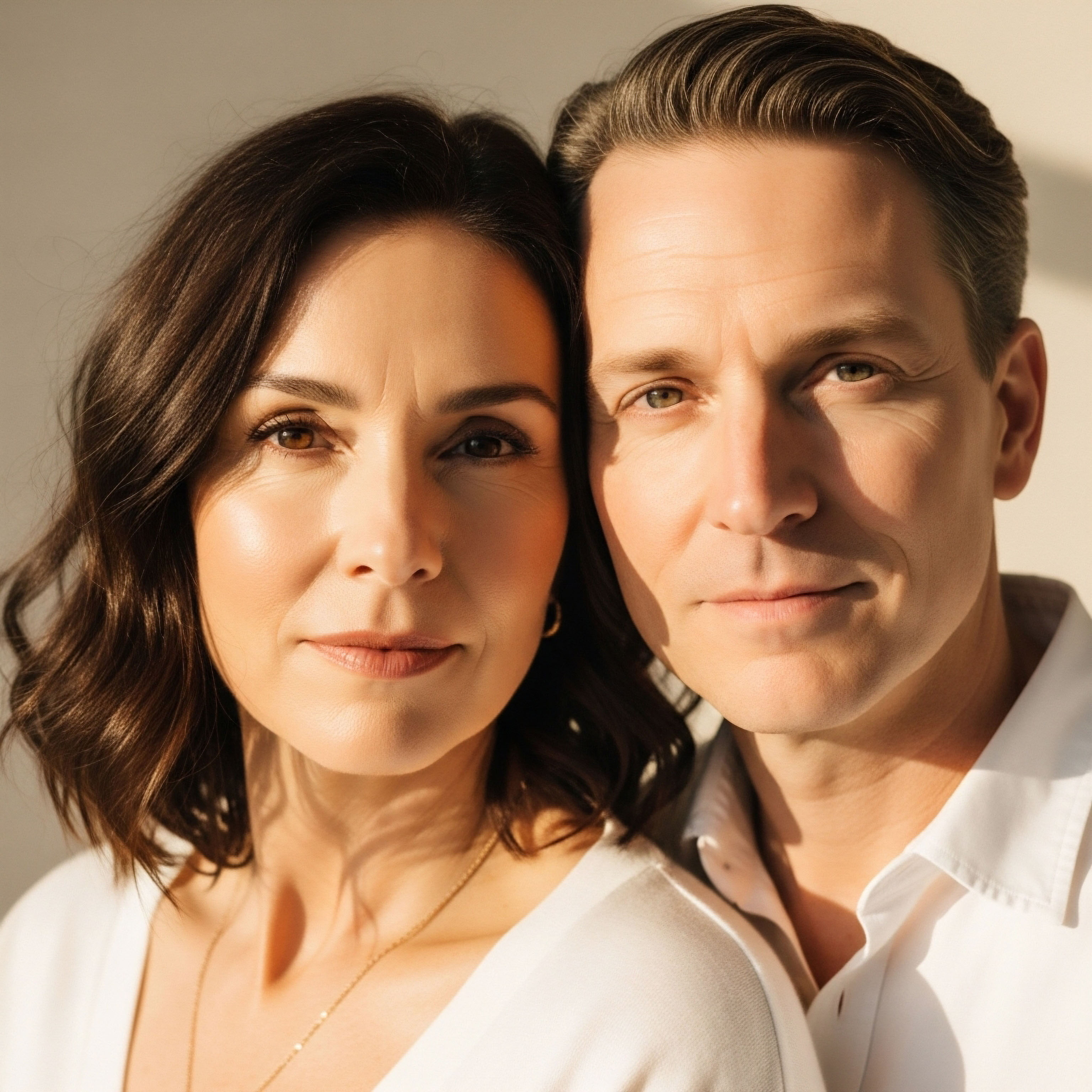

Fundamentals
Your body is a responsive, dynamic system, and the feeling of vitality you are seeking is a direct reflection of its internal balance. When you begin a hormonal protocol, you are introducing a powerful set of instructions into this system.
The question of how effectively these instructions are received and acted upon is where your daily choices become profoundly significant. Consider your lifestyle as the environment in which these hormonal signals operate. A supportive environment amplifies their intended message, leading to the results you seek ∞ be it renewed energy, mental clarity, or physical strength. An unsupportive one, conversely, can create static and interference, diminishing the protocol’s efficacy.
This journey is about understanding the conversation between your therapeutic protocol and your biological reality. The food you consume, the quality of your sleep, the way you manage stress, and your physical activity are not separate from your treatment. They are integral components of it. Each one modulates the body’s sensitivity to hormonal signals.
For instance, chronic stress elevates cortisol, a hormone that can interfere with the function of testosterone and thyroid hormones. Similarly, poor sleep disrupts the foundational rhythms of the entire endocrine system, creating a backdrop of hormonal chaos that can undermine even the most precise therapeutic interventions. Recognizing this interconnectedness is the first step toward reclaiming your well-being.
Lifestyle choices directly shape the body’s internal environment, which in turn determines how effectively a hormone protocol can deliver its intended benefits.
The foods you eat provide the literal building blocks for hormones and influence the pathways that metabolize them. A diet rich in nutrient-dense whole foods provides the essential vitamins and minerals required for hormone synthesis. Conversely, a diet high in processed foods and sugar can promote inflammation and insulin resistance, creating metabolic disruption that directly counteracts the goals of hormonal optimization.
Physical activity does more than just burn calories; it enhances insulin sensitivity and can positively influence levels of key hormones like testosterone and estrogen. Regular movement acts as a powerful signal to your body, reinforcing the messages of vitality that your hormone protocol is designed to deliver.
Think of your hormone protocol as a key designed to unlock a specific door to wellness. Your lifestyle choices determine how well that key fits and turns in the lock. By aligning your daily habits with your therapeutic goals, you are not just passively receiving treatment; you are actively participating in your own biological recalibration. This is a process of partnership with your own body, where you provide the optimal conditions for it to heal and function at its peak.


Intermediate
To appreciate how lifestyle factors modulate hormonal protocols, we must examine the specific biological mechanisms at play. Your endocrine system functions as a complex network of feedback loops. Hormonal therapies, such as Testosterone Replacement Therapy (TRT) or treatments for perimenopausal symptoms, introduce external signals into this network. The efficacy of these signals is contingent upon the health of the entire system, which is profoundly influenced by diet, exercise, and stress management.

The Critical Role of Nutrition in Hormone Metabolism
The foods you consume directly impact how your body processes and utilizes supplemental hormones. For individuals on TRT, diet is a critical variable. Protein intake, for example, is essential for building the muscle mass that TRT helps to support. Lean protein sources provide the amino acids necessary for muscle protein synthesis, amplifying the anabolic effects of testosterone.
Healthy fats are also crucial, as cholesterol is the precursor to all steroid hormones, including testosterone. A diet rich in monounsaturated fats from sources like avocados and olive oil supports the structural integrity of cell membranes, which is vital for hormone receptor function.
Certain micronutrients play a direct role in testosterone metabolism. Zinc is a key mineral for male reproductive health, as it is involved in the synthesis of testosterone. Magnesium is also important, as it can help to reduce oxidative stress, which has been shown to negatively impact testosterone levels. Conversely, a diet high in processed foods and sugar can lead to insulin resistance, a condition that is closely linked to lower testosterone levels and can diminish the effectiveness of TRT.
A nutrient-dense diet provides the essential cofactors for hormone synthesis and metabolism, directly enhancing the therapeutic potential of hormonal interventions.
For women undergoing hormone therapy for perimenopause or post-menopause, nutrition is equally important. Phytoestrogens, found in foods like flaxseed and lentils, can have a mild estrogenic effect, potentially complementing the actions of prescribed hormones. A diet that stabilizes blood sugar is also key, as fluctuations in insulin can exacerbate the hormonal imbalances characteristic of this life stage.

How Does Exercise Amplify Hormonal Signaling?
Physical activity acts as a potent modulator of hormonal health, enhancing the body’s sensitivity to both endogenous and supplemental hormones. For men on TRT, resistance training is particularly beneficial. Lifting weights stimulates muscle protein synthesis, creating a demand for the testosterone that the therapy provides.
This synergy between exercise and testosterone can lead to greater gains in muscle mass and strength than either intervention alone. Aerobic exercise also plays a role by improving cardiovascular health and helping to manage body weight, which is important for maintaining a favorable hormonal profile.
For women in perimenopause and menopause, exercise offers a multitude of benefits that support the goals of hormone therapy. Weight-bearing exercises are critical for maintaining bone density, which can decline as estrogen levels fall. Regular physical activity has also been shown to alleviate common menopausal symptoms like hot flashes and mood swings, and it can improve sleep quality. By reducing stress and improving overall well-being, exercise creates a physiological environment in which hormone therapy can be more effective.
- Resistance Training ∞ This form of exercise is particularly effective at building muscle mass and increasing the body’s sensitivity to anabolic hormones like testosterone. It involves activities like weightlifting and bodyweight exercises.
- Aerobic Exercise ∞ Activities like running, swimming, and cycling improve cardiovascular health and help to regulate insulin levels, which is crucial for overall hormonal balance.
- Mind-Body Practices ∞ Yoga and Pilates can help to reduce cortisol levels, the body’s primary stress hormone. High cortisol can interfere with the function of other hormones, so managing stress is a key component of any hormonal protocol.

The Impact of Sleep and Stress
Sleep and stress are two of the most powerful, yet often overlooked, factors influencing hormonal health. Chronic stress leads to elevated levels of cortisol, which can have a catabolic effect on the body, breaking down muscle tissue and promoting fat storage. This directly counteracts the intended effects of many hormone therapies. High cortisol can also interfere with the production and function of other hormones, including testosterone and thyroid hormone.
Sleep is when the body performs many of its essential restorative functions, including hormone production. A lack of quality sleep can disrupt the natural diurnal rhythm of hormone release, leading to imbalances that can undermine the effectiveness of a therapeutic protocol. For example, a significant portion of daily testosterone production occurs during sleep. Therefore, consistently poor sleep can contribute to lower testosterone levels, even in individuals on TRT.
| Lifestyle Factor | Mechanism of Action | Impact on Hormone Protocol Efficacy |
|---|---|---|
| Diet | Provides essential building blocks and cofactors for hormone synthesis and metabolism. Influences insulin sensitivity and inflammation. | A nutrient-dense diet enhances the body’s ability to utilize supplemental hormones. A poor diet can create metabolic disruption that counteracts therapeutic goals. |
| Exercise | Improves insulin sensitivity, stimulates muscle protein synthesis, and reduces stress hormones. | Amplifies the effects of hormone therapy, particularly in relation to muscle mass, bone density, and mood. |
| Sleep | Regulates the diurnal rhythm of hormone release and supports cellular repair. | Adequate sleep is essential for optimal hormone production and function. Poor sleep can disrupt hormonal balance and diminish therapeutic outcomes. |
| Stress Management | Reduces levels of cortisol, a hormone that can interfere with the action of other hormones. | Lowering stress levels creates a more favorable hormonal environment, allowing therapeutic protocols to work more effectively. |


Academic
A sophisticated understanding of hormone protocol efficacy requires a systems-biology perspective, examining the intricate interplay between exogenous hormones and the endogenous regulatory networks that govern metabolic health. The hypothalamic-pituitary-gonadal (HPG) axis serves as the central control system for reproductive hormones, and its function is profoundly modulated by lifestyle-dependent variables.
When a patient embarks on a protocol such as Testosterone Replacement Therapy (TRT), the intervention is not occurring in a vacuum. It is introduced into a complex, dynamic environment shaped by nutritional inputs, physical stressors, and neuroendocrine signals.

Nutrigenomics and Hormonal Optimization
The interaction between diet and the genome, known as nutrigenomics, offers a compelling lens through which to view the modulation of hormone therapy. The foods we consume provide more than just calories; they deliver bioactive compounds that can influence gene expression and, consequently, hormonal pathways.
For example, the composition of dietary fats can alter the fluidity of cell membranes, which in turn affects the function of hormone receptors embedded within them. A diet rich in omega-3 fatty acids, for instance, can enhance cellular sensitivity to hormones like testosterone, thereby potentiating the effects of TRT.
Furthermore, specific dietary patterns can influence the activity of enzymes involved in hormone metabolism. A high-protein diet, for example, has been shown in some studies to affect the levels of sex hormone-binding globulin (SHBG), the protein that transports testosterone in the blood.
Alterations in SHBG levels can change the amount of bioavailable testosterone, the portion of the hormone that is free to exert its effects on target tissues. This highlights the importance of a well-formulated diet as an adjuvant to hormone therapy, capable of fine-tuning the therapeutic response at a molecular level.
The molecular interactions between dietary components and hormonal pathways can significantly influence the bioavailability and cellular action of therapeutic hormones.
For women undergoing hormone therapy during the menopausal transition, dietary choices can also have a profound impact. The gut microbiome, which is heavily influenced by diet, plays a crucial role in the metabolism of estrogens. Certain gut bacteria produce enzymes that can deconjugate estrogens, allowing them to be reabsorbed into circulation. A healthy gut microbiome, supported by a diet rich in fiber and fermented foods, can therefore contribute to a more balanced hormonal state, complementing the effects of prescribed therapies.

The Mechanotransduction of Hormonal Signals
Exercise, particularly resistance training, initiates a process called mechanotransduction, where mechanical forces on muscle cells are converted into biochemical signals. These signals can activate pathways that lead to muscle protein synthesis, such as the mTOR pathway. Testosterone plays a permissive role in this process, amplifying the cellular response to mechanical loading. Thus, for an individual on TRT, resistance exercise creates a physiological context in which the supplemental testosterone can be most effectively utilized for muscle hypertrophy and strength gains.
The benefits of exercise extend beyond the musculoskeletal system. Regular physical activity improves insulin sensitivity, which is of paramount importance for hormonal health. Insulin resistance, a condition often exacerbated by a sedentary lifestyle and poor diet, can lead to a state of chronic low-grade inflammation.
This inflammatory environment can disrupt the function of the HPG axis and reduce the efficacy of hormone therapies. By improving insulin signaling, exercise helps to create a more favorable metabolic milieu, allowing for a more robust response to hormonal interventions.
- HPG Axis Regulation ∞ The hypothalamic-pituitary-gonadal axis is the primary regulatory pathway for sex hormones. Its function can be disrupted by chronic stress, poor nutrition, and lack of sleep.
- SHBG Modulation ∞ Sex hormone-binding globulin levels can be influenced by diet and other lifestyle factors, affecting the amount of bioavailable testosterone.
- Insulin Sensitivity ∞ Improved insulin sensitivity, often achieved through diet and exercise, is crucial for reducing inflammation and supporting overall hormonal balance.

What Are the Neuroendocrine Implications of Stress and Sleep?
The neuroendocrine system, which integrates the nervous and endocrine systems, is highly sensitive to the effects of stress and sleep deprivation. Chronic activation of the hypothalamic-pituitary-adrenal (HPA) axis, the body’s central stress response system, results in sustained high levels of cortisol.
Cortisol can exert an inhibitory effect on the HPG axis, suppressing the production of gonadotropin-releasing hormone (GnRH) from the hypothalamus. This can lead to reduced production of luteinizing hormone (LH) and follicle-stimulating hormone (FSH) from the pituitary, ultimately impairing testicular or ovarian function.
In the context of hormone therapy, elevated cortisol can directly antagonize the effects of supplemental hormones. For example, cortisol’s catabolic properties can counteract the anabolic effects of testosterone, limiting gains in muscle mass. Sleep deprivation acts as a potent stressor on the HPA axis, further contributing to this state of hormonal dysregulation.
Given that a significant pulse of testosterone is released during deep sleep, chronic sleep restriction can have a direct, negative impact on testosterone levels, potentially necessitating higher doses of TRT to achieve the desired therapeutic effect.
| Factor | Biological System | Molecular/Cellular Impact |
|---|---|---|
| Nutrient Composition | Metabolic Pathways | Alters enzyme activity (e.g. aromatase, 5-alpha reductase), influences SHBG levels, and provides precursors for steroidogenesis. |
| Resistance Exercise | Musculoskeletal System | Activates mTOR pathway for muscle protein synthesis, enhances androgen receptor density in muscle cells. |
| Chronic Stress | HPA Axis | Elevates cortisol, which can suppress GnRH release and antagonize the anabolic effects of testosterone. |
| Sleep Quality | Endocrine Rhythms | Disrupts the diurnal release of key hormones, including testosterone and growth hormone, and contributes to HPA axis dysregulation. |

References
- Whittaker, J. & Harris, M. (2022). Low-carbohydrate diets and men’s cortisol and testosterone ∞ Systematic review and meta-analysis. Nutrition and Health, 28(4), 553-564.
- Anderson, K. E. Rosner, W. Khan, M. S. New, M. I. Pang, S. Wissel, P. S. & Kappas, A. (1987). Diet-hormone interactions ∞ protein/carbohydrate ratio alters reciprocally the plasma levels of testosterone and cortisol and their respective binding globulins in man. Life sciences, 40 (18), 1761 ∞ 1768.
- Prasad, A. S. (1996). Zinc ∞ The role of zinc in growth and development. The Journal of Trace Elements in Experimental Medicine, 9(1), 1-19.
- Patisaul, H. B. & Jefferson, W. (2010). The pros and cons of phytoestrogens. Frontiers in neuroendocrinology, 31(4), 400-419.
- He, Y. & Li, H. (2021). The gut microbiota ∞ a new regulator of bone metabolism. Frontiers in Endocrinology, 12, 638012.
- Gleason, C. E. Carlsson, C. M. Johnson, S. Atwood, C. & Asthana, S. (2005). Clinical pharmacology and differential cognitive efficacy of estrogen preparations. Annals of the New York Academy of Sciences, 1052, 93-115.
- Kraemer, W. J. & Ratamess, N. A. (2005). Hormonal responses and adaptations to resistance exercise and training. Sports medicine, 35(4), 339-361.
- Vingren, J. L. Kraemer, W. J. Ratamess, N. A. Anderson, J. M. Volek, J. S. & Maresh, C. M. (2010). Testosterone physiology in resistance exercise and training ∞ the up-stream regulatory elements. Sports Medicine, 40(12), 1037-1053.
- Broussard, J. L. & Turek, F. W. (2011). The role of sleep and circadian rhythms in the regulation of metabolism and body weight. Nature Reviews Endocrinology, 7(10), 589-597.
- Kyrou, I. & Tsigos, C. (2009). Stress hormones ∞ physiological stress and regulation of metabolism. Current opinion in pharmacology, 9(6), 787-793.

Reflection
The information presented here provides a map of the biological landscape you are navigating. It illustrates the profound connections between your daily actions and your internal hormonal environment. This knowledge is a tool, one that allows you to move from a passive recipient of care to an active architect of your own well-being.
The path to sustained vitality is a personal one, built upon a foundation of self-awareness and informed choices. Consider how these principles apply to your own life and what small, consistent adjustments you can make to support your body’s journey toward balance. The power to influence your health is, in large part, already in your hands.



